My Flea Market Crate Digging Dozen
Treasures For $3 Or Just Junk?
I've been buying records in antique and second-hand stores, thrift shops, and Goodwills since 1965. In my town, there was a Goodwill store with a large display table, approximately six feet by four feet, piled high with hundreds of unsleeved 45 rpm records priced at two for five cents. I would go through them every few weeks searching for Beatle records, always unsuccessfully, except once when I found a new copy of Swan 4182 "Sie Liebt Dich (She Loves You)"/"I'll Get You"). Now, very clean, it's worth approximately $50.
None of my friends had ever heard "Sie Liebt Dich," and owning the record made me envied at the record playing get togethers in the neighborhood. It was my first rare record thrill. I was hooked.
As the sixties went on into the early '70s, I had more money and could buy new records, but I always searched the thrift stores. I was buying albums now. They only cost twenty-five cents, so I'd buy records if the cover had psychedelic lettering and a picture of guys with long hair or if I'd heard the music was good. I bought the first Moby Grape, the first Grateful Dead, a Muddy Waters album, and the Clear Light album without ever having heard them. I spent my twenty-five cents on some losing bets, too—Vanilla Fudge's The Beat Goes On, the Scaffold LP (Paul McCartney's brother), a Fever Tree album, etc. Every few months, I'd make an amazing "how did that ever end up here?" find---three Beatles albums on Parlophone, Dylan's "I Want You" picture sleeve 45 with the live "Just Like Tom Thumb's Blues" on the flip, the Kink's out of print Kontroversy and Kinkdom albums, the Stones Got Live If You Want It! EP.
The boutique used record stores that began to open in the mid-1970s had a huge impact on record hunting in the thrift stores. A few times, I found myself flipping through stacks of albums next to record store owners who went to Goodwill every day to hunt for stock. People who wanted to dispose of records began selling them to used record stores. "Store dumps" became common when the used record stores would donate hundreds or thousands of worthless, unsalable records to Goodwill. As a result, there were many more bad records to search through and far fewer good ones to find. By the early eighties finding a rare "on my want list forever" record at the thrift stores required such a large investment of time that it really wasn't worth it, but I kept searching. I just like looking at records.
The internet ended any lingering fantasies of "Someday, I'll buy Hank Mobley Blue Note 1568 in a thrift shop for a dollar." In the early 2000s, flea market sellers, second hand store owners, and sometimes, Goodwill began pricing records based on Discogs, EBay, and God help us, Amazon listings. Now, I see $20 stickers on Three Dog Night, Barbra Streisand and Seals & Crofts LPs, and Herb Alpert's The Lonely Bull can be mine for $10.
Due to the vinyl revival, many more people are combing through the flea markets and thrifts stores than at any time since the early, pre-CD 80s, and I don't remember the last time, but it's been years, since I found a jaw dropping, keep a straight face "holy sh..!" major rarity record in one. I've given up the hope of scoring "the grails" or even very desirable records such as clean condition classic rock, soul, or bop jazz in the Goodwills and flea markets, but searching is still fun.
The used record stores have overhead to pay, and bin space is at a premium. Selling records for less than $5 is not a model for a profitable business. Similarly, successful EBay and Discogs sellers know that the $5 LP, after factoring in the cost of the record, the fees, and the time expended in creating the listing, packing and shipping, is a money losing proposition. Today records worth less than $5 in stores or online usually end up in Goodwill and thrift stores which sell or try to sell them for $2 or $3.
Are the records at the Goodwill and the flea markets bad records? Many of them are bad, some very bad, in my opinion, but that is not why they are in thrift shops. They are there in crates amidst the Royal Crown Cola bottles, the Reader's Digest books, and the broken adding machines because they are not popular or desirable, and the almighty forces of the market have determined that that is where they belong. But the market for records is volatile, not rational or fair, and certainly not intelligent. Many records are in thrift shops because the artist is obscure or unfashionable, the genre is unfashionable, or people just don't know how good the record is.
A person who is willing to take a chance, is open minded, not just searching for the name artists and albums that everyone wants, and is able to shrug and say about the bad record they bought, "Well, at least I heard it" can find some very good LPs for only a little money in the Goodwills and thrift shops.
Hoping to prove my point, but not knowing what I would find, I went to one of the local antique malls where two local Ebay and Discogs record dealers have a booth and sell off their bottom tier stock for $3. I bought 11 LPs and limited myself to records I had never heard. I also avoided what I considered to be well known artists and passed on Steve Stills, Paul Simon, Moody Blues, ELP, and some other classic rock era stars. The next day, I went to a Goodwill store and bought one LP for $2. And yes, Goodwill was well stocked with Herb Alpert LPs. Total cost for 12 LPs, none below VG+ condition: $35 plus tax.
Here's what I bought:
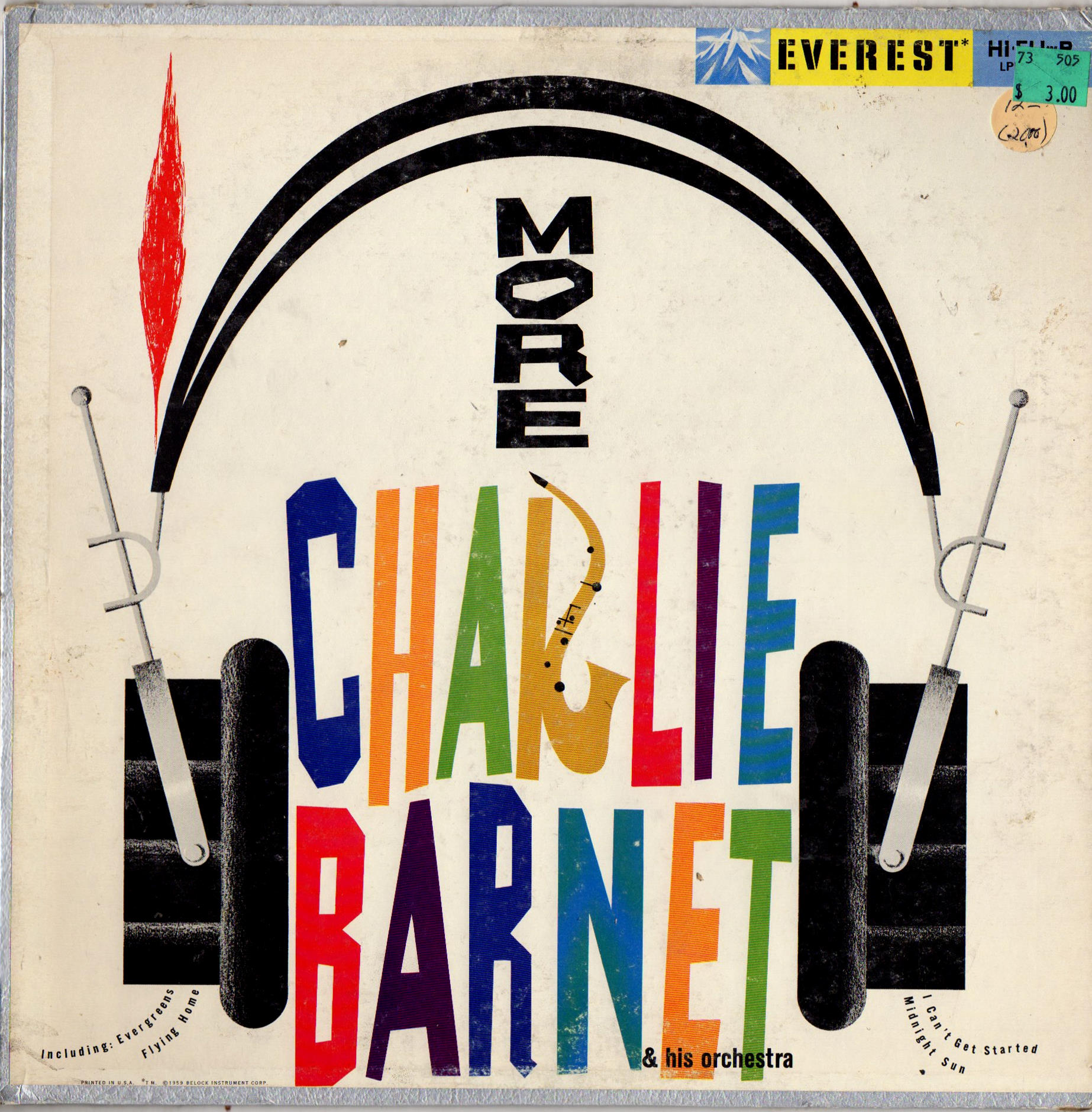 Charlie Barnet---More---Everest mono
Charlie Barnet---More---Everest mono
Charlie Barnet (1913-1991) was a saxophonist and leader of a popular big band during the Swing Era. On this 1959 album, he fronts a studio band of top New York City jazz guys playing swinging arrangements by the great Bill Holman. Phil Woods, Billy Byers, Frank Rehak, Milt Hinton, Carl (Doc) Severinsen, and Don Lamond all play on the album. Dick Hafer, who later recorded with Mingus, plays some nice tenor sax solos. The trumpet solos by Swing Era great Charlie Shavers are technically amazing but a bit show-offy. Barnet was only a journeyman saxophonist, and his solos are unswinging and the weakest part of the album. The tunes are all Big Band Era standards and short. This is a good, not especially creative big band album, but it is enjoyable to hear musicians of this caliber swinging hard and playing Holman's arrangements.
The music was recorded on 35 millimeter tape, and the dynamic range of the LP is very wide. Treble and bass are extended. The record sounds great in mono, but I'll bet the stereo is better, possibly stunning.
It was worth $3.
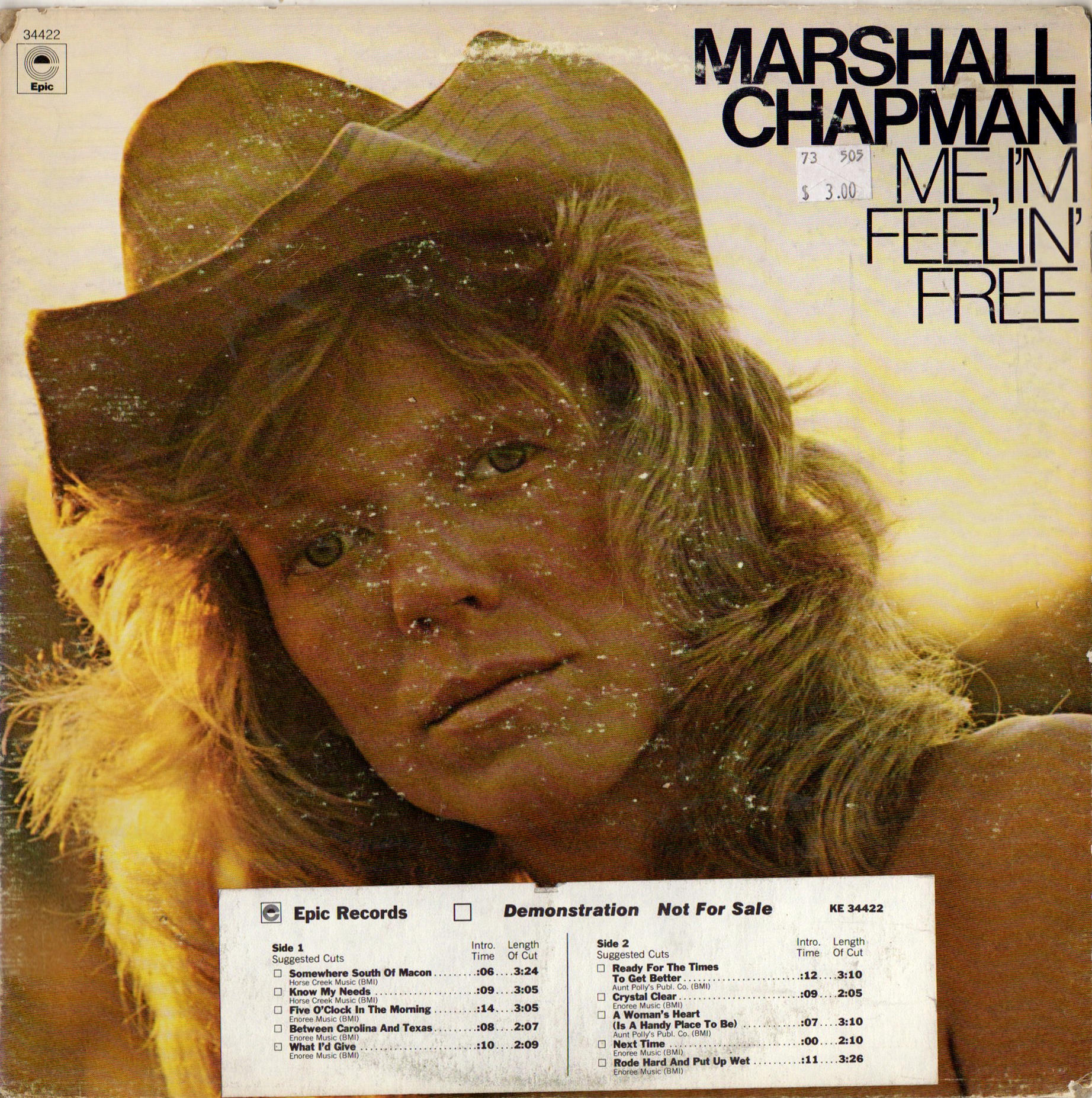 Marshall Chapman---Me, I'm Feelin' Free---Epic
Marshall Chapman---Me, I'm Feelin' Free---Epic
This 1977 album was Chapman's first. It's a country rock album that mixes the country styles of Kris Kristofferson, Waylon Jennings, and Bobbi Gentry, with '70s singer-songwriter intimacy and R&B. Chapman is an exceptionally talented singer. Her voice is powerful with a deep soulful blues feeling that is equal parts country and R&B. The closest comparison I can make is to the great but underappreciated Tracy Nelson. Chapman is that good.
All of the songs, but one, were written or co-written by her, and they show the disparate influences of John Prine and southern soul. It's an emotional, "hard hitting songs about hard hit people" album that brings to mind Townes Van Zandt but also Dusty In Memphis. The standout, "Somewhere South Of Macon," should be an oft covered classic. The melody is strong with a great "Angel From Montgomery" style chorus. But, maybe the lyric is too downhome and downbeat for the song to appeal to other singers. Or maybe Chapman's version with her passionate, angry, "telling my true story" vocal can't be equaled.
The accompaniment is by Nashville studio pros, and the playing and arrangements are superb. Unfortunately, Me I'm Feelin' Free, in 1977, was too raw, soulful, and "country" for both the country and rock charts. It's a forgotten classic album.
It was worth a lot more than $3.
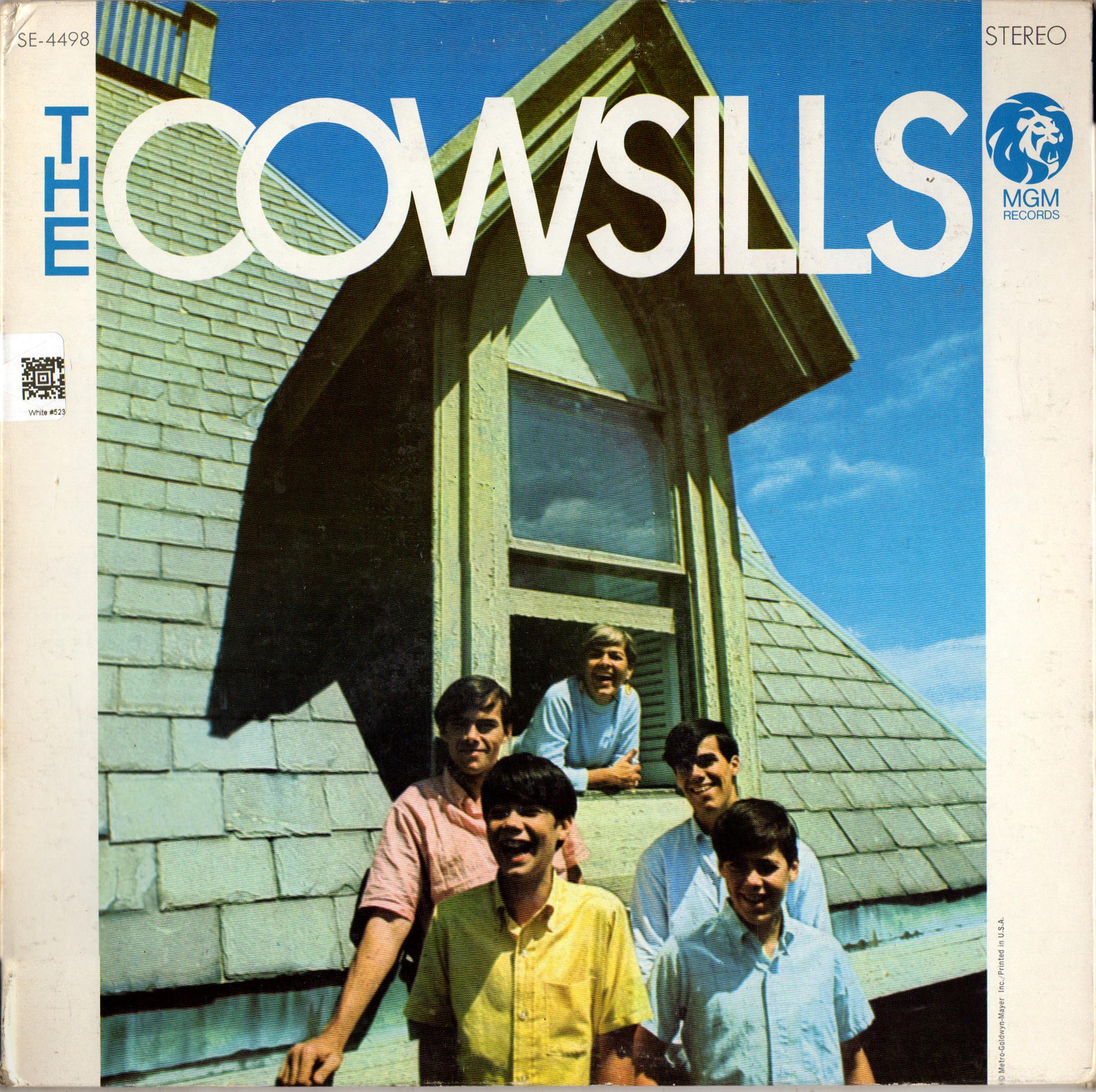 The Cowsills---MGM
The Cowsills---MGM
The Cowsills were a talented rock band consisting of four brothers aged 12 to 18 in 1967 when they were signed to MGM. Shortly after, their alcoholic, extremely abusive and manipulative father insisted that their mother join the band. The brothers were not happy, but their mom was in. Fortunately, she could sing. The already high Cowsill cuteness quotient was upped at least tenfold when the youngest sibling, Susan, joined at eight years old. She was a Shirley Temple type child prodigy, and the Cowsills became a favorite act of TV variety shows in 1968-1969. They were good looking, wholesome and their mother was onstage with them, so there was no danger of songs about drugs (at least not explicitly) or spending the night together.
The Cowsills, their first LP, was released in November 1967 and is a good "sunshine pop" album that is very derivative of the Beatles, the Beach Boys, and the Mamas and the Papas. While clever and fun, the arrangements in the baroque pop/George Martin style using harps, harpsichords, strings, and horns, are a bit overdone. Bill is a good lead singer, but their layered harmonies are the Cowsills' strength. While they do not sing as well as the Beach Boys or the Beatles, they sing very well. Most of the songs are ultra twee, but the #2 hit, "The Rain The Park and Other Things," is an enjoyable pop confection. "Dreams of Linda" and "River Blue" are good Beatle style pop songs that would not have been out of place on the albums of other and hipper bands.
The album is well crafted, but I'm not a fan of "sunshine pop," so for me, it was an "at least I heard it" experience.
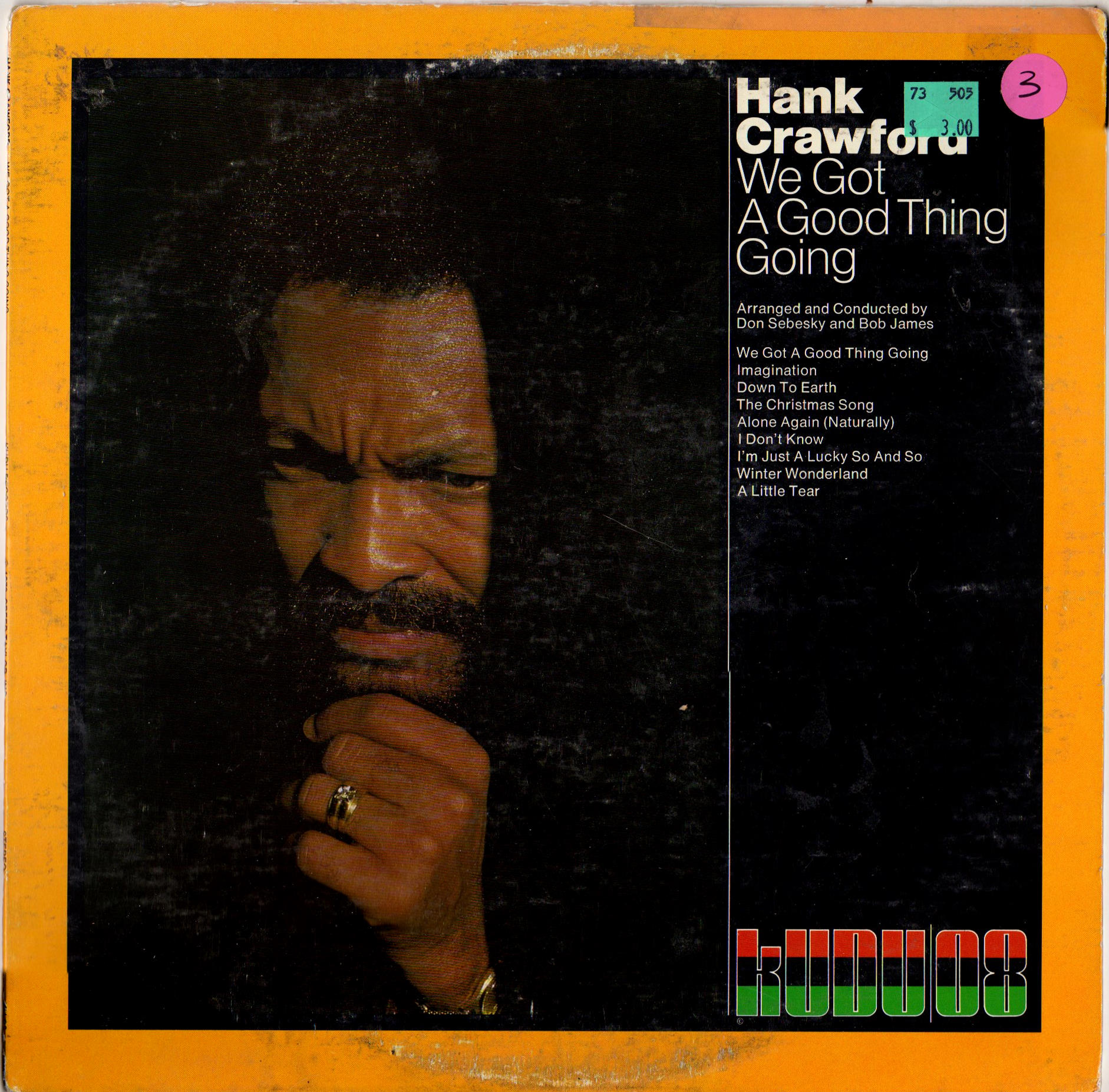 Hank Crawford---We Got A Good Thing Going---Kudu
Hank Crawford---We Got A Good Thing Going---Kudu
Alto saxophonist Hank Crawford (1934-2009) in 1972 recorded We Got A Good Thing Going, his second album for Kudu, and he continued the same formula that he had been using for years---instrumental versions of current pop and R&B vocal tunes, some standards and some blues. Crawford had been a popular saxophonist in Black music since the early '60s when he was a featured soloist in the Ray Charles Orchestra, but he was not a jazz musician. He was an R&B player with jazz influences, a master of playing the melody soulfully, then improvising on it while avoiding modern jazz harmonic complexity. His sound was big for an alto, warm and vocal. Most importantly, he never lost the groove.
We Got A Good Thing Going is a good Hank Crawford album. Everything he plays, even the standards, sounds bluesy and funky. As always, he stays within the boundaries of the style he has created---never too jazzy but never down and dirty either. His music was the hipper, less slick predecessor of today's "smooth jazz."
George Benson plays swinging melodic jazz guitar on most of the album. He's probably trying to stay close to the melody and not upset Hank, but he's such a virtuoso player that even reining himself in, he sounds beautif ul. Ron Carter is on bass for most of the album, and Bernard Purdie is the drummer. The arrangements by Don Sebesky and Bob James are sophisticated and not too slick. The recording was done by Rudy van Gelder, and the sound is very similar to the wide soundstage, smooth strings with mellow electric instruments sound he created for Kudu's sister label CTI.
It was worth more than $3.
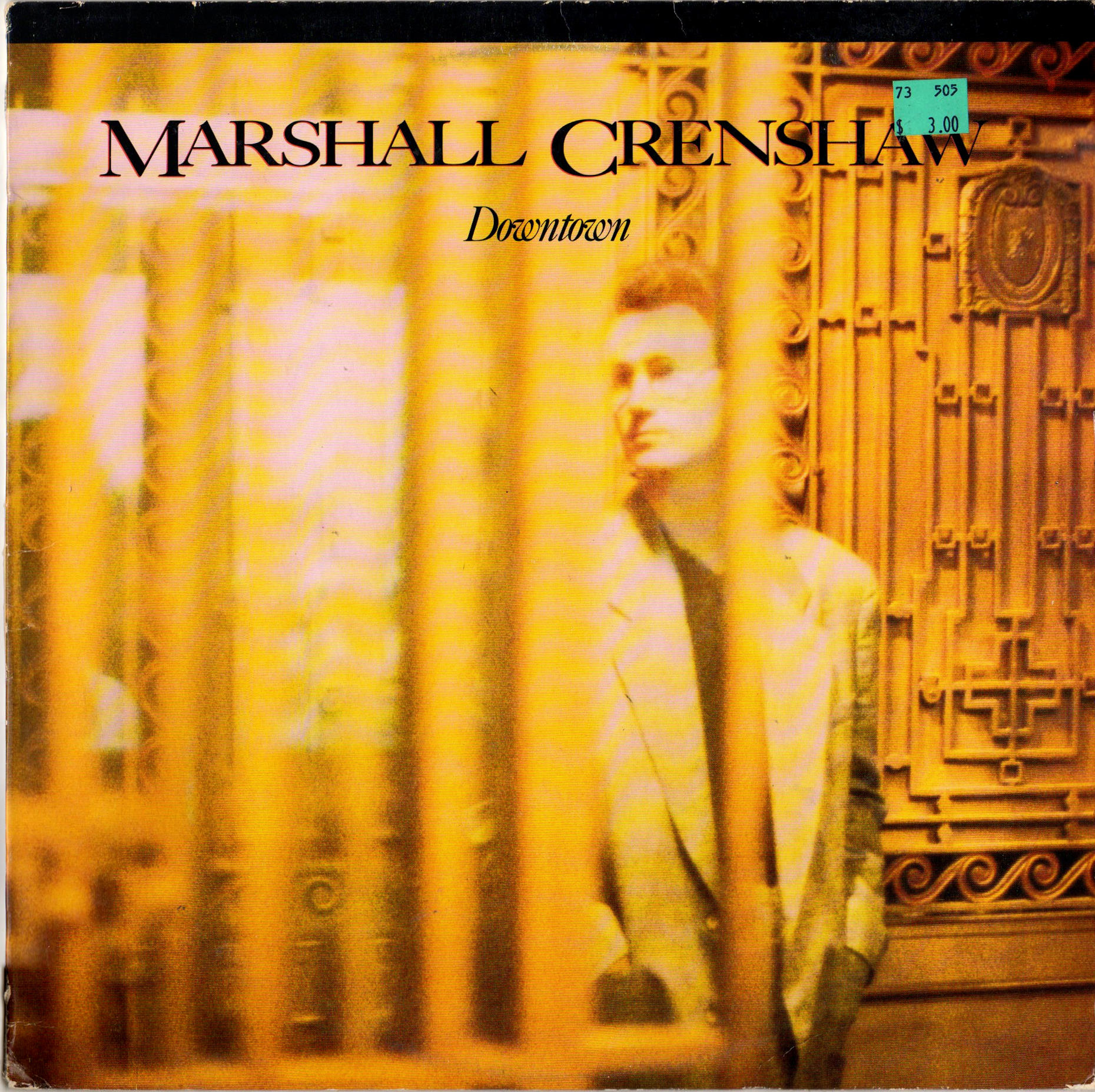 Marshall Crenshaw---Downtown---Warner Brothers
Marshall Crenshaw---Downtown---Warner Brothers
This 1985 album was Crenshaw's third. It was produced by himself, T-Bone Burnett, and Larry Hirsch, with Mitch Easter co-producing one cut with Crenshaw. Four studios were used, and five engineers worked on the album. There's a saying about too many cooks.
I thought the sound on the album was horrendous. Now, I'm supposed to list the audio shortcomings. Well, what have you got? Yeah, all of those. OK, I'll try to be specific. There is no high end on the recording. Cymbals are only a barely audible sizzle. There is no bass. Let's not forget the midrange, which is thin, harsh, and unpleasant. There is no soundstage. The record is near mono. Air, detail---are you kidding me? There is no dynamic range. Crenshaw's voice is down in the mix and so compressed it sounds like he's droning on constantly. The guitars lack crunch and impact. I won't start on the drum sound because I don't have enough space. The sound of this record is what a rock record is not supposed to be---boring.
The sound is so bad that I think a lot of Marshall Crenshaw is missing from this album. Crenshaw is obviously a talented singer and songwriter. It's unfortunate that the excitement, emotion, and fun---the rock 'n roll energy that I think he wanted to put into songs like "The Distance Between," "Blues Is King," and "I'm Sorry" is nowhere in evidence on this album.
Is this an early digital recording?
At least I heard it, but I wish I hadn't.
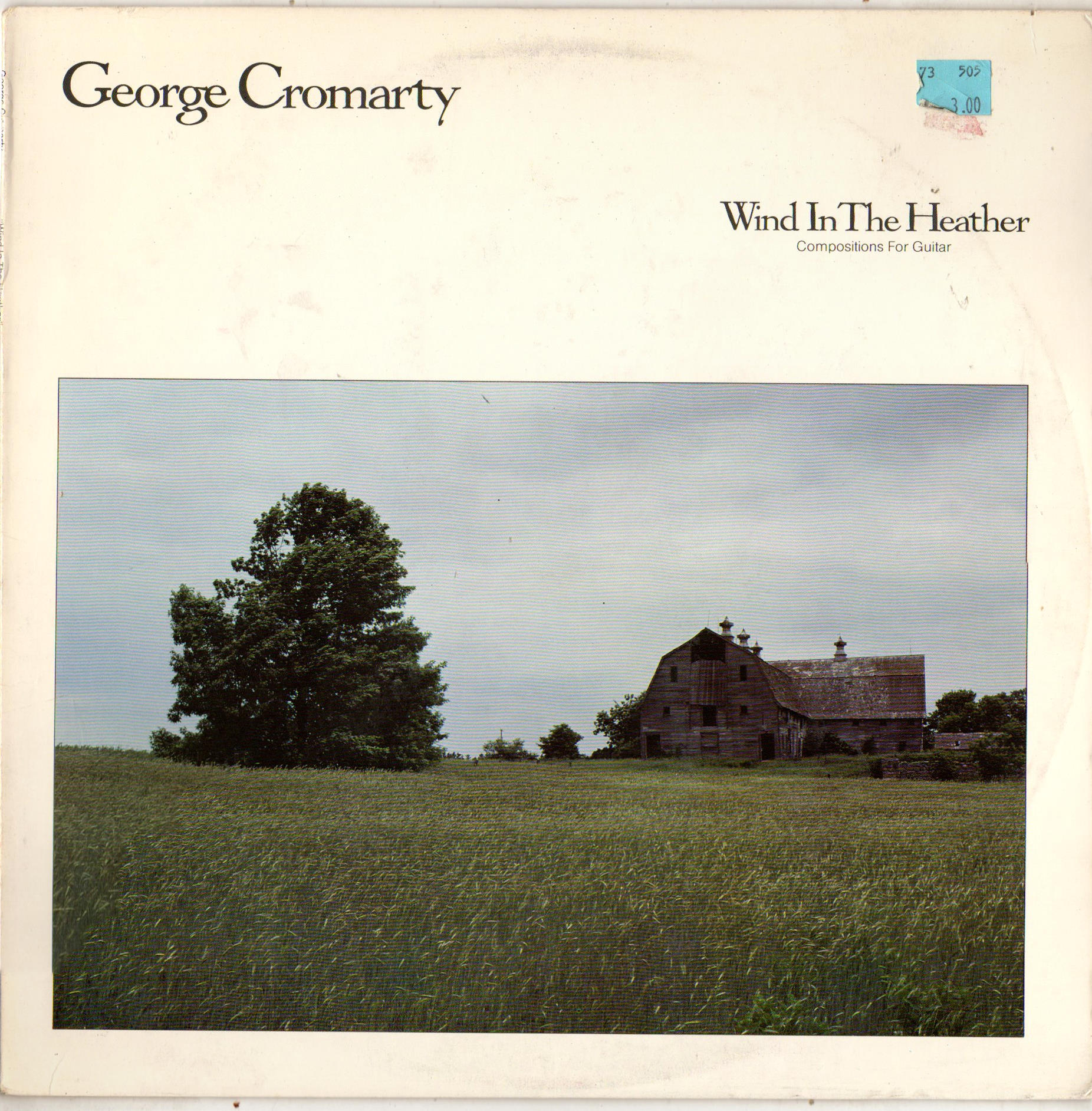 George Cromarty—Wind In The Heather---Dancing Cat
George Cromarty—Wind In The Heather---Dancing Cat
Cromarty (1941-1992) was a guitarist/composer. This album of his instrumental compositions for guitar was recorded in 1982 and 1983 and released on George Winston's Dancing Cat label in 1985. It was Cromarty's third and final album.
The little writing that has been done about Cromarty usually groups him with, incorrectly, I think, the so called "American Primitives"- John Fahey, Robbie Basho, Leo Kottke, etc. Unlike the "primitives," Cromarty's primary influence was classical guitar music, especially the clean picking, precise rhythm feel, and clear, smooth, resonant sound of Julian Bream. Echoes of blues or folk players can occasionally be heard but are fleeting. His compositions are heavily influenced by folk music, but it is British folk music as filtered through classical composers like Ralph Vaughan Williams, Henry Purcell, and John Dowland.
Cromarty was an immensely talented guitarist. On Wind In The Heather, he continually plays two, sometimes three, simultaneous melodic lines and the most complex passages with complete ease. His solid time when playing different rhythms against each other is like that of a jazz drummer. The ability to play melodies with the beauty and feeling of a great singer is an ability few acoustic guitarists possess. Cromarty has it.
This album will sound samey and new agey as background music but beautiful if listened to with the attention it deserves.
The guitar is very well recorded, and mastering was done by Bernie Grundman.
It was worth more than $3.
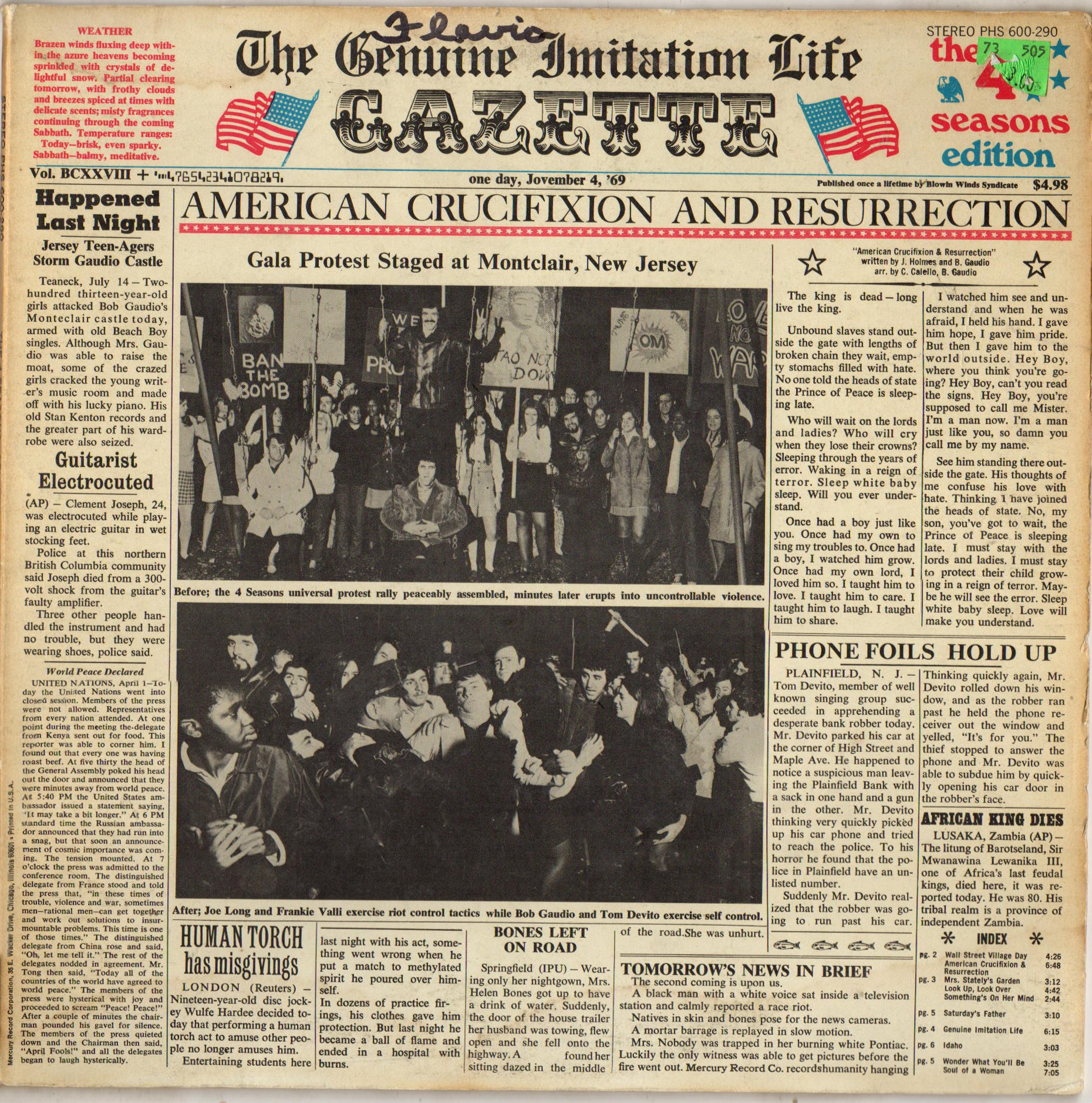 The Four Seasons---The Genuine Imitation Life Gazette---Phillips
The Four Seasons---The Genuine Imitation Life Gazette---Phillips
This is the Four Seasons' arty pop-psych album from 1969. Yeah, the Jersey Boys, the "Big Girls Don't Cry," guys, the squarest major group in '60s American pop music. Those Four Seasons, not some obscure British band with the same name. Things were getting weird in the late '60s. When the Four Seasons are freaking out, the center cannot hold, and it's time to batten down the hatches America.
A lot of revisionist history claims this is a classic album. I'd like to gain some hip cred by raving about Life Gazette and show that I'm not one of those old guy Guitar Rock worshippers, but sadly, I can't. Maybe a Kraftwerk or Metal Machine Music article is what I need to write. Anyway, Life Gazette is not a classic. It's goofy, pretentious, half-baked, and square. It's what you'd expect if the Four Seasons sat around listening to Sgt. Pepper, Pet Sounds, and Odessey and Oracle for a month and decided they should let their hair grow, try out some mustaches, buy some beads, get freaky, and make a record to sell to the hippies.
"Mrs. Stately's Garden" is an excellent pop-psych song and very reminiscent of the Zombies. The rest of the album is mostly typical Four Seasons pop with psychedelic touches and some weirdness. A lot of Life Gazette sounds like an imitation of Smile, or more likely, an imitation of Smiley Smile.
The album is nicely recorded with a wide soundstage. Bob Ludwig mastered it.
At least, I can say I heard it.
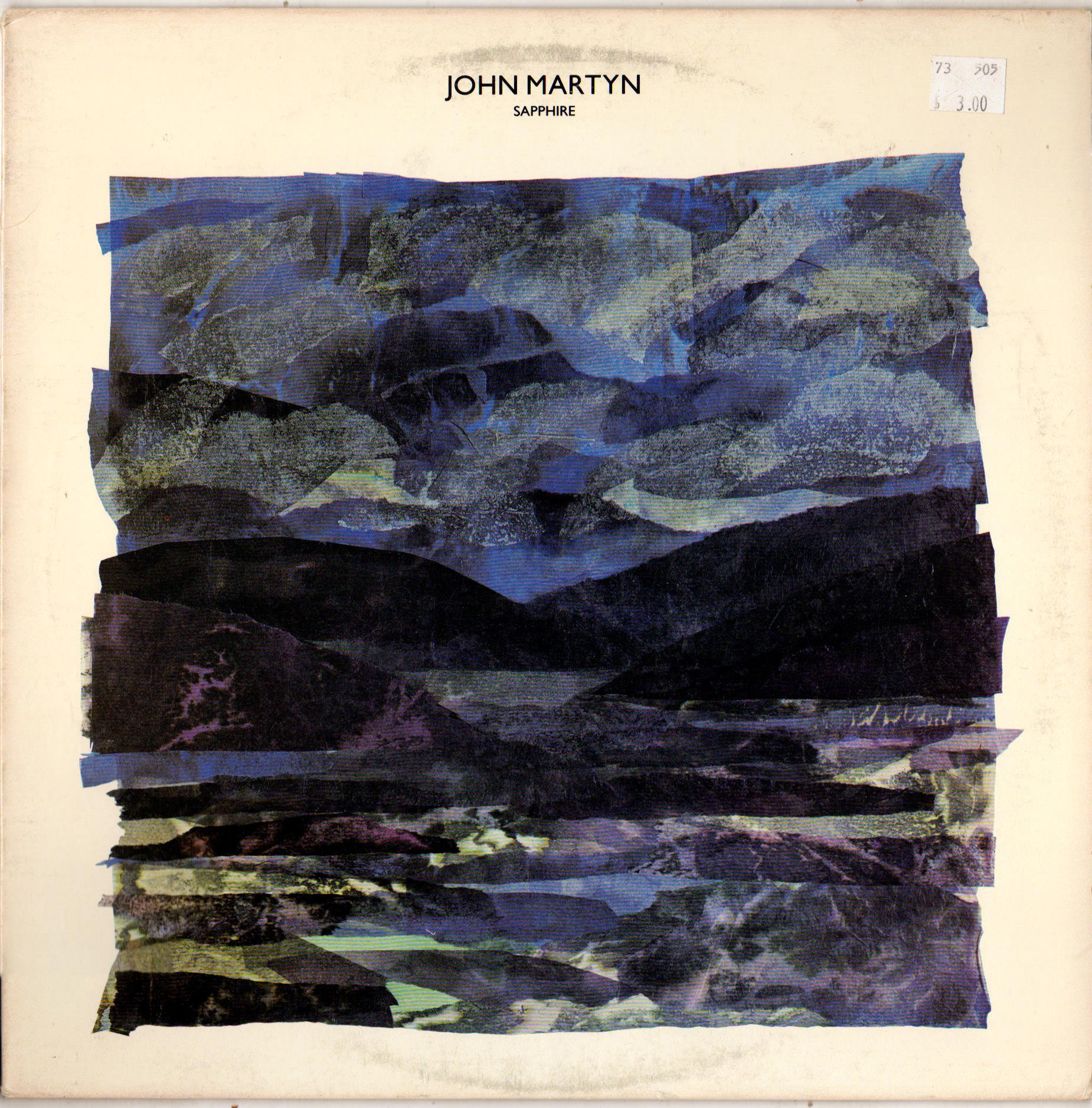 John Martyn---Sapphire---Island
John Martyn---Sapphire---Island
John Martyn (1948-2009) began his career as a singer/songwriter in the early to mid-'60s British virtuoso acoustic guitar folk-blues-jazz style pioneered by Davy Graham. After two artistically successful 1970 folk/rock duo albums with his then-wife, Beverly, he began playing free form guitar solos through an echoplex. For the rest of his life, he experimented with various styles: jazz, reggae, hard rock, world music, and mixed them with his singing and songwriting.
Sapphire, released in 1984, is Martyn's '80s synth pop album. The songs are good, some very good but are not radio or dance club friendly. Whether Martyn was hoping for some commercial success or was artistically restless, presenting these songs in what was then a contemporary pop setting was an odd and, I think, misguided decision.
The synthesized keyboard sounds are minimalistic, generic, and a poor match for Martyn's melodies. His guitar is heard only rarely and then run through a synthesizer. The booming, artificial Linn drum machine sound is very dated, and the stiff, repetitive beats are inappropriate accompaniment for Martyn's singing style. The slurred, jazz like, rhythmically loose vocals are warm and human and are the best part of the album, but they sound like they were dubbed over the tracks for a long forgotten, not very good, 80's synth pop album.
At least, I heard it.
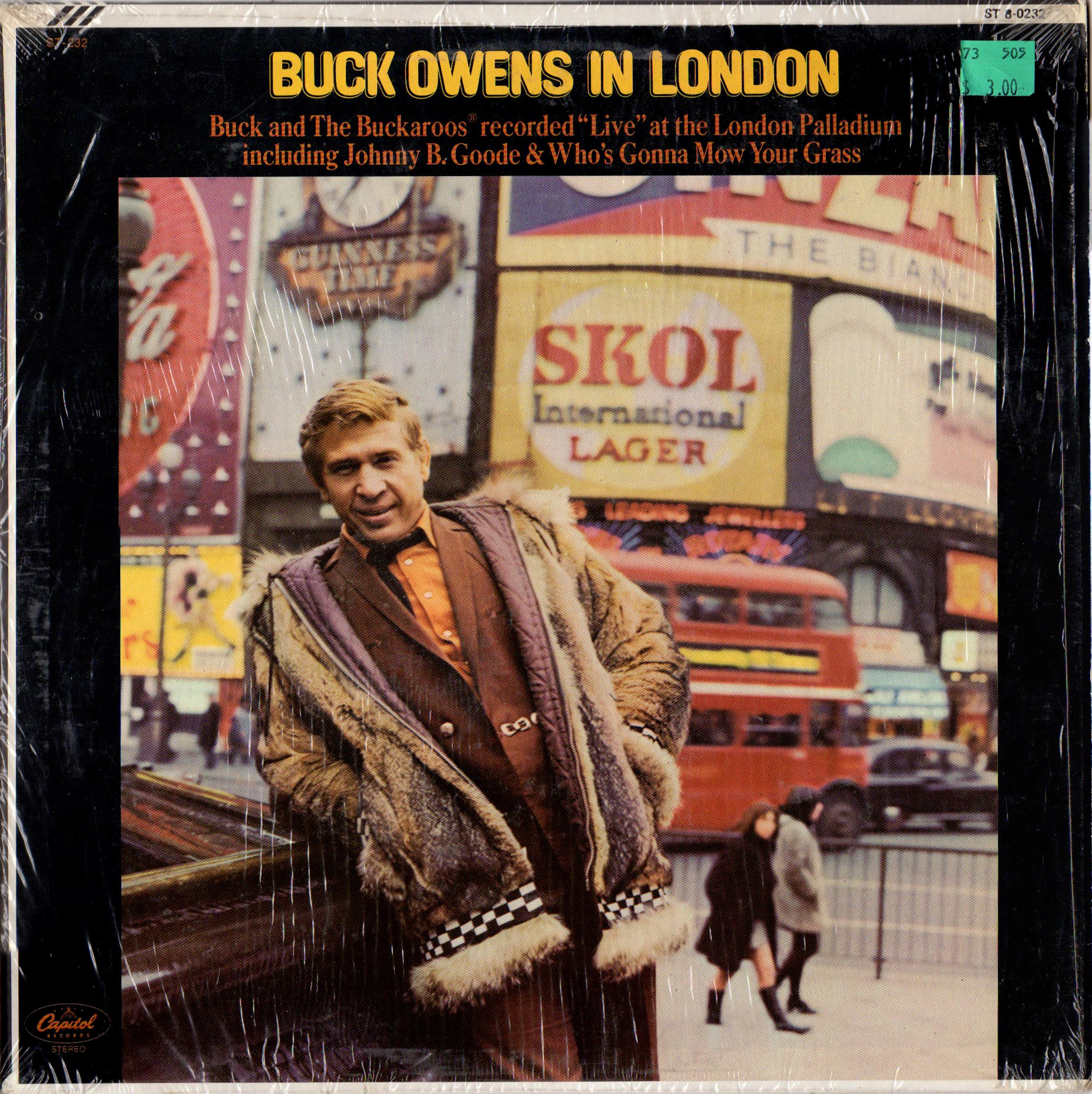 Buck Owens---In London---Capitol
Buck Owens---In London---Capitol
Recorded live in London in 1968 by Geoff Emerick ("Geoffrey Emeric" on the sleeve) of Beatles engineering fame, this album captures one of the greatest country singers, Buck Owens (1929-2006), and his band, the Buckaroos, playing country rock as well as anyone ever has.
Buck, veteran of thousands of shows by 1968, knew how to size up an audience, and after opening with "Happy Times Are Here Again," he sings "Act Naturally," and the first notes are greeted with cheers. Dare I say, "This version rocks harder than the Beatles?" Then, after "Together Again" with a typically intense vocal by Buck, he announces they have written a special "country rock song" for London called "A Happening In London." It's a rocking surf/country instrumental with a "Wipeout" drum break and some steel guitar from Jay Dee Maness that shows he'd been listening to psychedelic music. Then Buck sings some of his dozens of country radio hits, including a wonderful "Love's Gonna Live Here" powered by great drumming and with some Don Rich guitar that shows who Clarence White of the Byrds studied when he began playing electric.
Rich takes up his fiddle, and he and Buck do a short country/Cajun set that must have had the Londoners dancing. The show ends with an all out rocking "Johnny B. Goode" sung in harmony by Owens and Rich.
Despite a few minor mistakes, some off mic vocals and instrumental imbalances, this is a good live recording that may not check all the audiophile boxes but captures the excitement of what must have been a special show for Buck and the band.
The superb singing and the top notch pro combo playing make clear that Buck and His Buckaroos were one of the greatest ever country rock bands.
It was worth way more than $3.
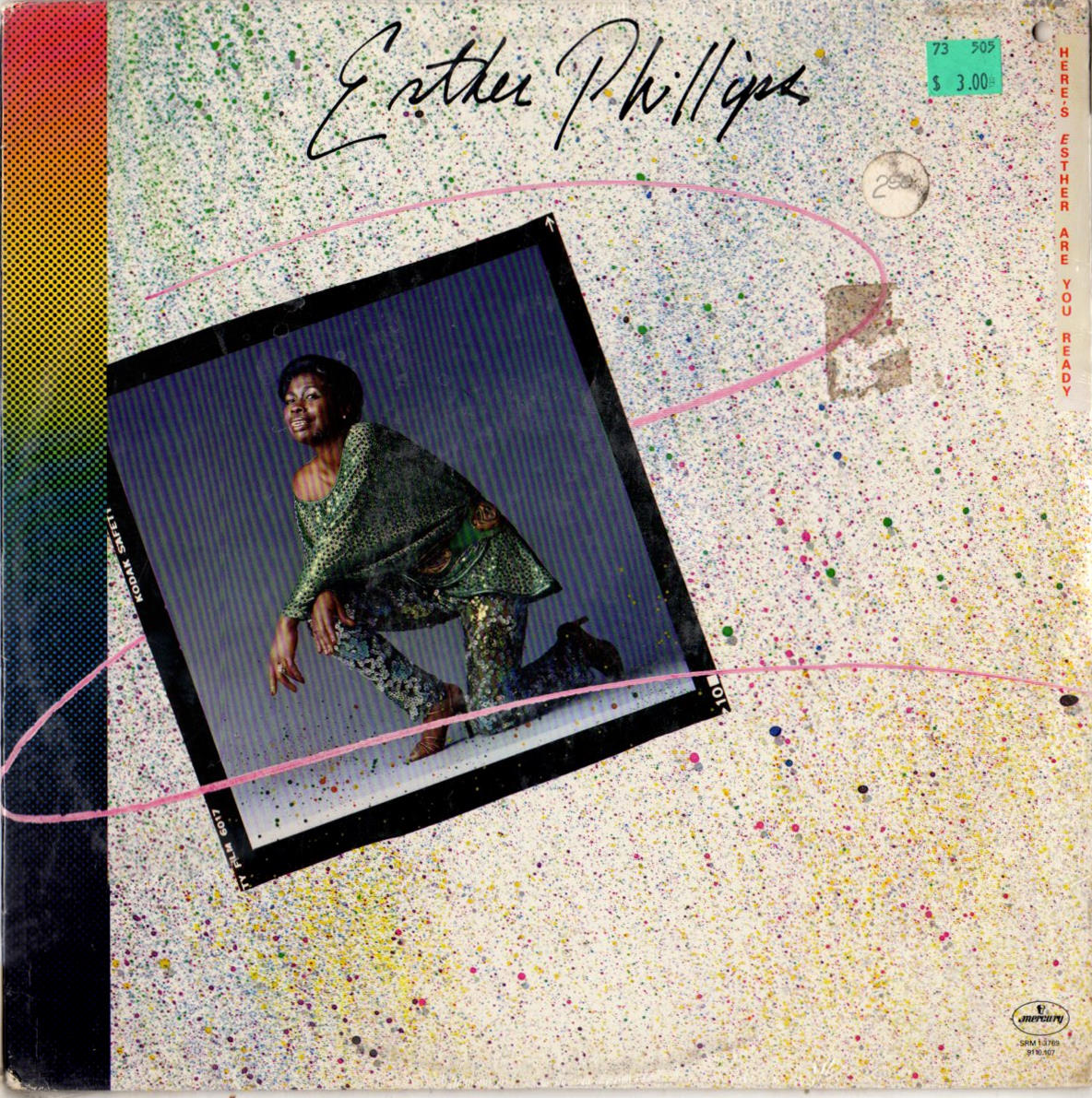 Esther Phillips---Here's Esther…Are You Ready---Mercury
Esther Phillips---Here's Esther…Are You Ready---Mercury
Esther Phillips (1935-1984) became a major star in Black music at fifteen when "Double Crossing Blues," recorded with Johnny Otis, became a #1 R&B hit in 1950. She had several other hit records that year. By the mid-1950s, her records weren't selling, and she was addicted to heroin. She would struggle with addiction her entire life, and the effects of it would cause her death.
Throughout the sixties, she would have occasional hits and recorded the classic album Burnin' Live at Freddie Jett's Pied Piper for Atlantic. In 1972, for Kudu, she recorded the LP widely regarded as her masterpiece, From A Whisper To A Scream which included her version of Gil Scott-Heron's "Home Is Where The Hatred is." It was the perfect mating of singer and song, deep as life and death. In 1975, she had a major top 40 hit with a disco version of "What A Difference A Day Makes," a song associated with Dinah Washington, her greatest influence. For the rest of her life, her records were aimed at the pop/R&B/disco market.
Here's Esther, released in 1979, is an unadulterated disco album with chanting backup singers, dance breaks, thumping bass drum, breezy string arrangements---all of it. The album was produced by the great Harvey Mason, drummer for the Headhunters, etc., etc. Five arrangers are mentioned on the sleeve, and those responsible for Phillips' hair, make-up, clothes, and jewelry, but no musicians are listed.
The music is formulaic, '70s TV cop show soundtrack disco. It sounds like Phillips is singing to pre-fab, ready for any singer disco tracks. She is not the type of singer for this music. Her phrasing is too loose and fluid for the rigid disco beat. Thin and tart, soulful with a blue tinge of despair, hers is not a voice for raucous party starting. It's unfortunate that Phillips had the need and/or desire to record this type of material.
With utmost respect for the great Esther Phillips, I have to say, "at least I can say I heard it, but never again, I hope."
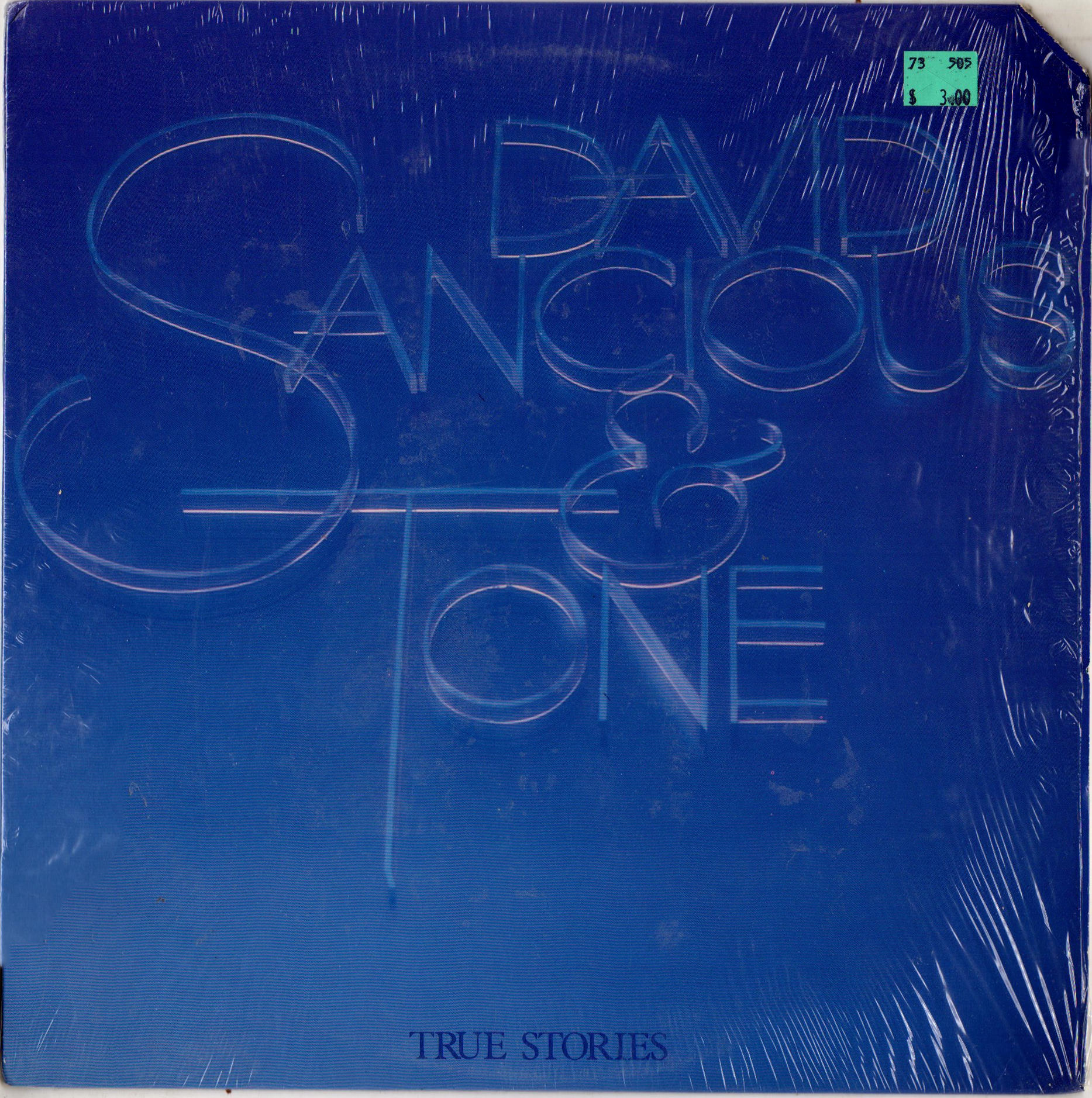 David Sancious & Tone ---True Stories---Arista
David Sancious & Tone ---True Stories---Arista
David Sancious is a virtuoso master of keyboard instruments, an excellent guitarist, and a creative, original composer. Though he has established himself as a first call session player and a touring sideman to superstars like Peter Gabriel, Sting, Jeff Beck, and Bryan Ferry, he is probably best known for his contributions, as a member of the E Street Band, to Bruce Springsteen's first three albums. Under his own name and as "David Sancious & Tone," he released five albums between 1975- 1979 that were overlooked upon release and are little remembered today.
The music on True Stories is best described as British Prog rock mixed with Return To Forever style jazz fusion and R&B. The album was released in 1978, a few years past the heyday of both jazz fusion and Prog Rock and, probably as a commercial concession, singer Alex Ligertwood was added to Tone. He had sung with Brian Auger's Oblivion Express and went on to be the singer for Santana for several extended periods. He's one of those big voiced, great range, overly dramatic '80s singers, and for me, he's hard to take and hard to ignore. Tone's bass player Gerald Carboy and drummer Ernest Carter are superb musicians. I don't know why Carboy and Carter are not mentioned in discussions of the great fusion rhythm sections.
Sancious' playing on various synthesizers is brilliantly creative, displaying amazing chops and musical imagination, and is more sophisticated than the playing of all the famous Prog Rock keyboard virtuosos. There are some gorgeous, classically influenced synthesizer interludes on True Stories that superstar Prog Rock bands would have turned into side long epics. He even plays some nice acoustic jazz piano. The compositions have strong melodies and clever arrangements that layer and juxtapose interesting synth sounds, but too frequently use the "build up to the dramatic vocal chorus" cliché.
True Stories has many moments of brilliance, but unfortunately, the arena rock-style vocals were a constant annoyance.
The album was co-engineered and produced by Eddy Offord, well known for his work with Yes. The sound is very big and dynamic, with a wide soundstage. Bob Ludwig did the mastering.
A record with great playing by Sancious, Carboy, and Carter is worth more than $3.
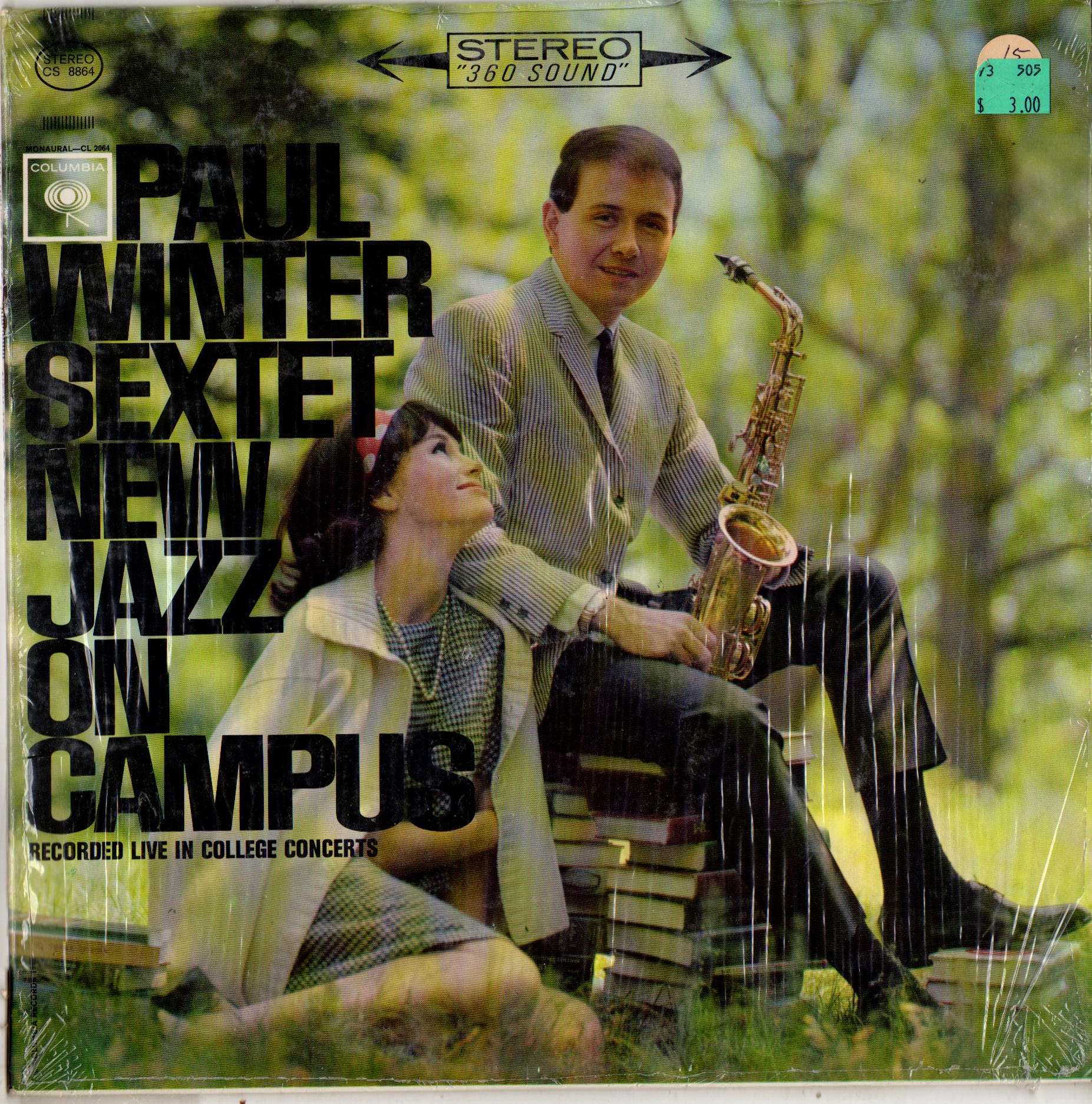 Paul Winter Sextet---New Jazz On Campus---Columbia
Paul Winter Sextet---New Jazz On Campus---Columbia
Paul Winter (b.1939) has had a long, very successful career playing a mixture of classical, folk, and world music that utilizes recordings of animals and the sounds of nature as well as improvisation. However, in 1963, when New Jazz On Campus was released, all that music was in the future, and Winter was a no hyphen jazz saxophonist.
New Jazz was recorded live, and Columbia was clearly trying to cash in on the success of Dave Brubeck's string of college albums. The silly cover photo of a shockingly young Winter sitting on a pile of books while a model gazes adoringly at him and his sax grossly misrepresents the album's contents. The Winter Sextet's music is considerably more modern and advanced than Brubeck's "college jazz," and I think it would have been challenging listening for all but the hippest students.
The Sextet's rhythm section—bassist Chuck Israels (Bill Evans Trio), drummer Ben Riley (Thelonious Monk Quartet), and pianist Warren Bernhardt (Steps Ahead, Steely Dan music director) was adventurous and modeled on the Bill Evans Trio. Baritone saxophonist Jay Cameron was a hard swinger with a big sound and the Sextet's best soloist. Dick Whitsell was a capable player in the Chet Baker/Miles Davis middle range melodic style. Winter's playing was a less funky version of Cannonball Adderley with hints of Charlie Parker.
The music on New Jazz is east coast hard bop with soft edges, influenced by Miles Davis, Gerry Mulligan, and Cannonball Adderley who were, for a young band in 1962, the cats to learn from. While certainly not at the level of Coltrane, Miles, or Adderley as soloists, the horns were creative and could swing. New Jazz On Campus, if not a masterpiece or a classic, is a surprisingly adventurous and well played album.
It was worth more than $3.
No The Lonely Bull or Whipped Cream & Other Delights.

















































